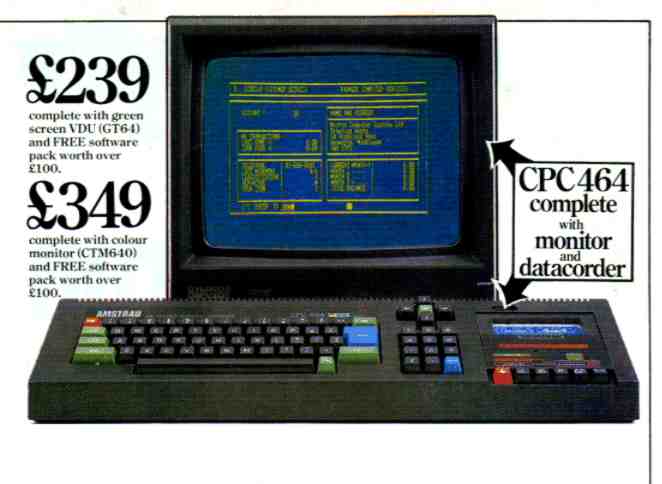| Alan Sugar - Amstrad and the CPC |
| Written by Historian | ||||||
Page 2 of 2
The computer boomIn 1982 Alan had become interested in the growing computer boom. Companies like Sinclair Electronics had made money building small cheap and very innovative machines. They looked as if they were mass consumer products but in reality they were only suitable for the computer enthusiasts. The reason for the boom was that there were suddenly a lot of computer enthusiasts! In the early days the market wasn’t quite right for the Amstrad approach but this didn’t stop Alan keeping his eye on it and learning about computers. In early 1983 he contacted two engineers who had done some work for Amstrad and asked them to design the hardware and software for a personal computer. In the meantime he and Bob Watkins, Amstrad’s technical director, worked on how the machine should look. Without having the insides completed they designed the plastic case, complete with built-in tape recorder. Again Alan was convinced the putting units together in the same case would lower the price and make the computer more attractive. He had bought some existing machines to learn about the subject and he was amazed at how difficult they were to get working. His machine would be a one-piece unit with keyboard and monitor as standard. At the time it was the norm for personal computers to share the domestic TV set and this was a major cause of family friction! However by the summer of 1983 it became clear that the two engineers weren’t making progress – designing a computer isn’t like designing an amplifier and the software designer cracked under the pressure. Watkins took what he had of the machine to Ambit, an electronics equipment and component retailer which had done work for Amstrad in the past. The managing directors, William Poel and Roland Perry, were soon enthused enough to take on the role of project managers and promised to complete the machine.
William Poel Roland Perry had been in the microcomputer business for some time and had been involved in designing small machines before. He was unimpressed by the work that had already been carried out and decided to start again with a new team of engineers.
Roland Perry One of the biggest problems was that the machine needed a version of Basic in ROM. At the time Microsoft made most of its profits selling its Basic in ROM but the Amstrad machine would need something cheaper to appeal to a mass market. Perry turned to an old school and university friend, Howard Fisher, who had just finished a software project for Acorn. This had been done in conjunction with Chris Hall and Richard Clayton and together they had formed a partnership called Locomotive Software. Perry contacted Locomotive Software and showed them the machine – which really only amounted to the plastic moulding! Clayton suggested that Perry contacted Mark-Eric Jones, nicknamed Mej, another Cambridge connection. When Perry showed the machine to Mej it became even more clear that they didn’t really have a starting point – half of the chips weren’t even connected to the power supply! The key factor was time – they were well behind schedule and the project hadn’t really got going. Locomotive reckoned it would take eight months to implement a version of Basic for the 6502 processor used in the first design. However for a Z80-based machine it would take less time. Given they had so little hardware complete it was decided that Mej would start from scratch and build a Z80-based machine and Locomotive would produce a Basic for it. The machine was code-named Arnold. Alan Sugar had a lot of input into the higher level aspects of the design – much as Steve Jobs was the guiding hand behind the Mac project. Alan decided that the machine should be "big” so it looked like value for money. He kept the price of the monitor down by using TV grade tubes and he found a line of cheap 3-inch disk drives that were just beginning to lose the standards battle with the 3.5-inch drive. He was also very clear that the machine had to have 64Kbytes of memory. This was the maximum that the current machines could have and, like the Watts power rating of an amplifier, it was the one numerical measure that the average customer could grasp.
A 3 inch disk Locomotive Software and Mej were given all of this detail at a meeting with Alan and they went away with mixed feelings. They had really not much idea who Alan Sugar was or what Amstrad was – they knew someone who had bought an Amstrad tape recorder and had vowed never to buy anything by Amstrad ever again! However they were drawn to the challenge. It isn’t often that a large electronics company asks three people to build a computer. They all felt that their association with Amstrad would be temporary and they weren’t optimistic about the chances of success. At the time the BBC Micro was selling well and Commodore had entered the market. Based on these opinions Mej asked for a flat fee for the design rather than a royalty. Locomotive Software settled for £45,000 in advance for the first two years. When asked about subsequent years Chris Hall didn’t think there would be any and so settled on £15,000 per annum. Of course we know that they were wrong. Roland Perry kept Amstrad happy by arranging demonstrations as the work progressed but in the main Mej and Locomotive were left to get on with the job. In December William Poel arranged for prototypes to be delivered to software companies which would write games for the new machine. At first they were difficult to convince that the machine was worth the effort – and many companies accepted the machine but did nothing with it. The final code for the machine, now called the CPC 464, was shipped to Japan for manufacture at the end of January 1984 and the finished machine was launched in April. There were three models – a green screen monitor for £299, a colour version for £329 and a version with built-in disk drive for £429. Unlike his audio equipment the UK computer press was quick to praise them as being the best value for money available at that time.
The CPC 464 was just the first Amstrad computers – it was followed up by the even more successful Amstrad PCW and its range of PCs – but that’s another story. If you are interested in how Amstrad developed and came to an end see the two articles that continue Alan Sugar's story PC-1512 and the fall of Amstrad
<ASIN:0262560445> <ASIN:1840245476> <ASIN:0764316001> <ASIN:0976385759> <ASIN:078214330X> <ASIN:0192862073> |
||||||
| Last Updated ( Sunday, 14 April 2024 ) |




